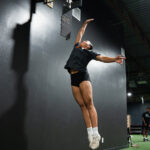Sports Specific Training for Volleyball Athletes
Volleyball is explosive. It requires split-second reactions, vertical power, and precise coordination. To truly dominate the court, athletes need more than just skill. They need sports specific training tailored to volleyball’s demands.
From diving digs to powerful serves, the sport challenges every part of the body. A custom training approach prepares athletes for these challenges—and helps them excel.
Why Volleyball Demands Specialized Training
Volleyball isn’t about long-distance running or general weightlifting. It’s about short, sharp bursts of effort combined with body control.
Essential skills include:
-
Vertical jumping for blocks and spikes
-
Lateral movement to cover the court
-
Core stability for hitting and serving
-
Shoulder durability to handle repetitive overhead motions
-
Reaction speed and agility for defense
Sports specific training hones these abilities in a controlled, progressive environment.
Benefits of Sports Specific Training for Volleyball
1. Increased Vertical Jump
Powerful legs and hips make you jump higher and hit harder. Plyometrics and weight training develop that explosiveness.
2. Faster Reaction Time
Training quick first steps and court awareness means getting to the ball quicker.
3. Shoulder and Core Strength
Serving, setting, and hitting all demand strong shoulders and stable cores. Focused work helps prevent overuse injuries.
4. Lower Injury Risk
Volleyball athletes face knee, shoulder, and ankle injuries. Smart training can strengthen and protect these joints.
5. Better Game Performance
When your body moves efficiently and powerfully, your technique improves naturally.
Volleyball Training Plan (Weekly Schedule)
| Day | Focus |
|---|---|
| Monday | Plyometrics + lower-body power |
| Tuesday | Lateral movement + reaction drills |
| Wednesday | Core and active recovery |
| Thursday | Upper-body strength + shoulder care |
| Friday | Game-speed agility + simulated plays |
| Saturday | Scrimmage-based conditioning |
| Sunday | Stretching, foam rolling, and rest |
Sample Volleyball-Specific Exercises
Depth Jumps to Spike Reach
Purpose: Boost vertical jump and simulate spike motion
How to do it: Step off a box, land, then jump as high as possible reaching with dominant hand. 3 sets of 5.
Band-Resisted Lateral Slides
Purpose: Improve defensive lateral quickness
How to do it: Place a resistance band above the knees. Shuffle side to side in low stance. 3 sets of 10 steps each way.
Overhead Medicine Ball Throws
Purpose: Build overhead power and coordination
How to do it: Throw a med ball upward and slightly forward like a spike. Catch and repeat. 3 sets of 8.
Shoulder External Rotations
Purpose: Strengthen rotator cuff and prevent injury
How to do it: Use a resistance band to rotate the arm outward from the body. 3 sets of 12 per arm.
Single-Leg Balance to Jump
Purpose: Develop ankle stability and balance
How to do it: Stand on one leg, stabilize, then jump and land on the same leg. Repeat 5 times per side.
Position-Specific Training Tips
Training can be adapted for each volleyball role:
-
Setters: Focus on agility, wrist strength, and upper-body endurance
-
Hitters: Emphasize vertical power, hip mobility, and shoulder durability
-
Liberos: Train quick reaction, low stance endurance, and lateral speed
This is the power of sports specific training—it builds athletes for their exact roles.
Recovery Is Just as Important
Volleyball is tough on the body. Smart athletes build recovery into their training.
Recommended Recovery Habits:
-
Foam rolling daily (especially calves, quads, and shoulders)
-
Active stretching after workouts
-
Icing shoulders or knees after intense sessions
-
Proper sleep, hydration, and nutrient timing
Prevent overuse injuries before they start. Learn more from NSCA’s volleyball training guidelines.
Why Training at Next Level Athletics Works
At Next Level Athletics, volleyball athletes get access to expert-designed sports specific training programs. Whether you’re building your vertical or coming back from an injury, they help you perform your best with smart, safe progressions.
Athletes work on strength, speed, and skill transfer—so the gains you make in training show up on the court.
Conclusion: Train for the Court
Volleyball is about more than raw power. It’s about controlled movement, speed, and repeatable effort. That’s why sports specific training is essential.
You don’t just play volleyball. You train for it. And when you do, your performance soars.


Recent Comments